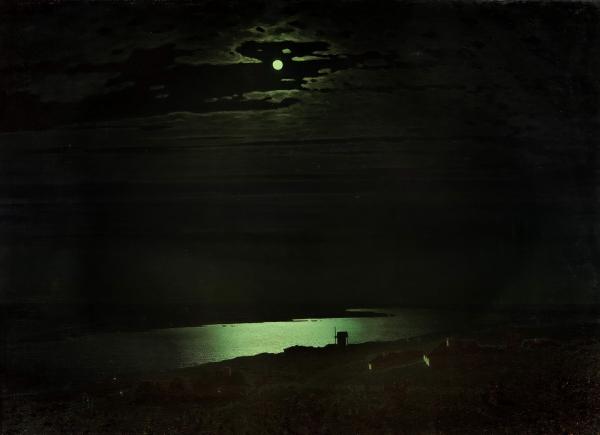The artist is Kuindzhi

Since 1880, the artist was busy searching for the image of the Dnieper. "Moonlight night" – One of the most impressive works. The picture is capable of perceived as a direct analogy with creativity n. AT. Gogol. It embodied the romantic concept of the image of southern nature. The basis of unique artistic effects, especially in the transfer of lighting – reflected phosphoric radiance, illuminated the river, are the search for completely new color expressiveness, experiments in the compilation and mixing of colors. The picture has not lost its charm to this day, although the color scheme has much darkened. This suggests that the main thing in it is not illusory, not a deception of vision, but a high system of poetic feeling, a sense of greatness of the universe, then "internal", in which the artist saw the meaning of the work. The picture was presented at a single -kind exhibition of one work in the company of encouraging arts and made "Incredible impression". However, shortly after an unheard of success, accompanied by the picture, the artist ceased to exhibit his work at exhibitions.
„Lunar Night on the Dnieper ” – the largest creative achievement of Kuindzhi. Kuindzhi reached in his new picture until the illusory and fantastic lighting effect, making the viewer as if to see one of his own reality of the lunar light, illuminated the sky with the ridges of the clouds and a slightly oscillating surface of the calmly current Dnieper. It was the highest take -off of the artist’s work. Having immersed nature into night darkness, reducing the details to a minimum, it gives a compressed expression of its poetic essence. This is facilitated by the high accuracy of the found figurative means: decorative color spots, their contrasts, modulation of light, spatial reversal of the composition. Demanding and sensitive to the slightest errors, the master was probably satisfied with the work. It is no accident that the only time he put in the picture for not only a year, but even the number – September 5, – having recorded the day of the end of his masterpiece.
Irina Shuvalova. Kuindzhi in the Russian Museum // Arkhip Kuindzhi. SPb, 2010. With.12-13.
Show the full text
Hide the full text
Detailed abstract
The artist dared to arrange an exhibition of only one of his paintings, strengthening the impression of lamp backlight. And the unprecedented success surpassed all expectations. „I am more tired of him, ”said the artist,“ than from the hardest work ”. However, the work was accompanied not only by extraordinary glory. Large tests fell on his lot. Such a large collector was about. T. Soldatenkov, but he was ahead of the Grand Duke Konstantin Konstantinovich, whose poetic nature was so close to this „Poem in colors “. On March 14, 1880, the Grand Duke described the first impression of this, not yet finished at that time in his diary: canvases: „It is breathtaking, you can’t break away from the blinding magical picture, the soul is longing for Kuindzhi that I buy his marvelous work, I deeply fell in love with the picture and could have sacrificed many for it ”. Unable to part with the acquired landscape, the prince took a precious canvas on the frigate, going into a round -the -world voyage. In Paris and. With. Turgenev, a hot fan of the artist’s talent, was in despair: „There is no doubt, ”he wrote D. AT. Grigorovich, that she [the picture] will return from there completely ruined thanks to the salty vapors of the sea and.”. The picture really suffered during the trip. She returned, as Kuindzhi himself said, in many places spoiled, there were scratches on her. The Grand Duke asked the artist to restore her . However, even after the author carried out, the picture could not be completely restored. Creating it, Kuindzhi intensively used bitumen, which darkens under the influence of light and air. Nevertheless, although very darkened, the canvas retained its extraordinary charm, becoming one of the jewelry of the exposition of the Russian Museum. Irina Shuvalova. Kuindzhi in the Russian Museum // Arkhip Kuindzhi. SPb, 2010. With.13-14.
Leave a Reply